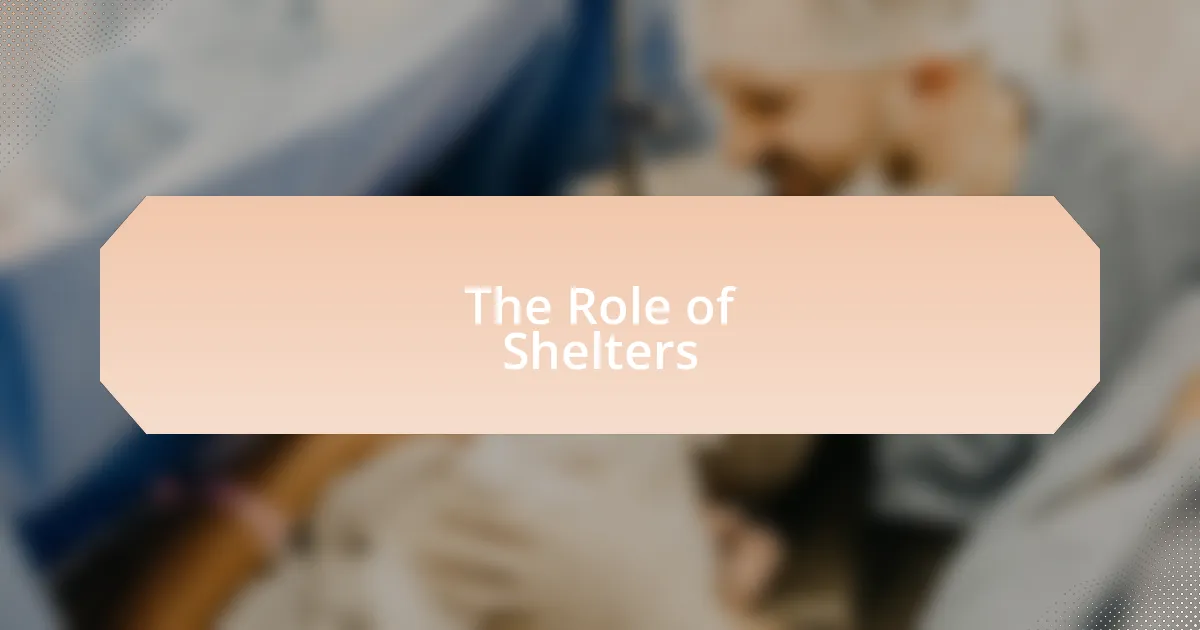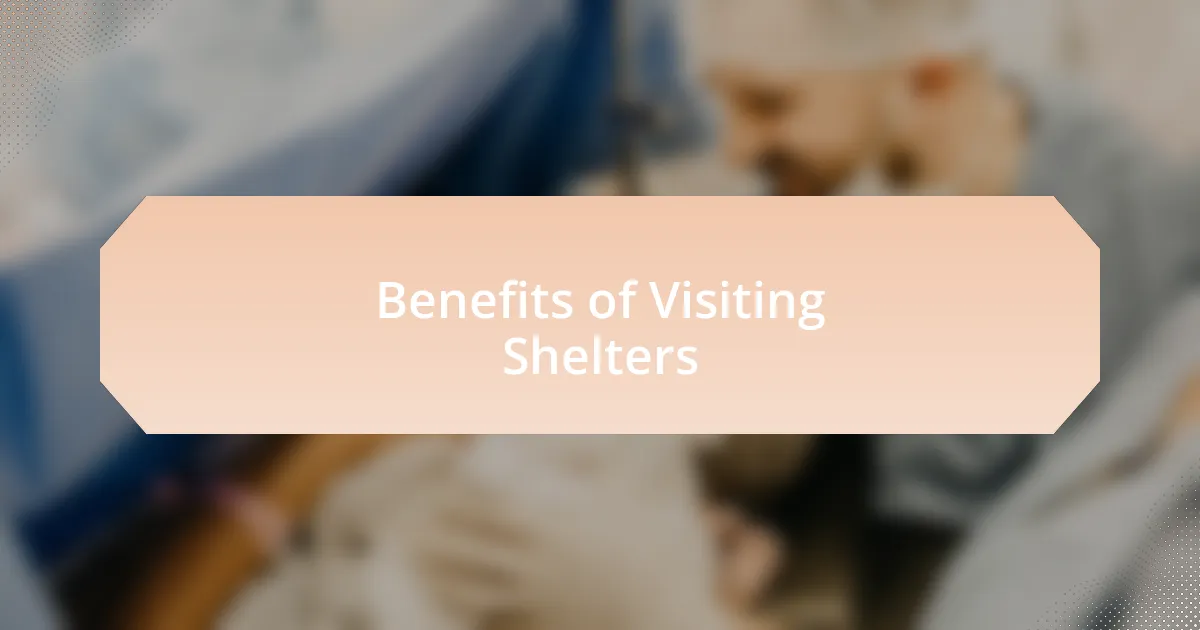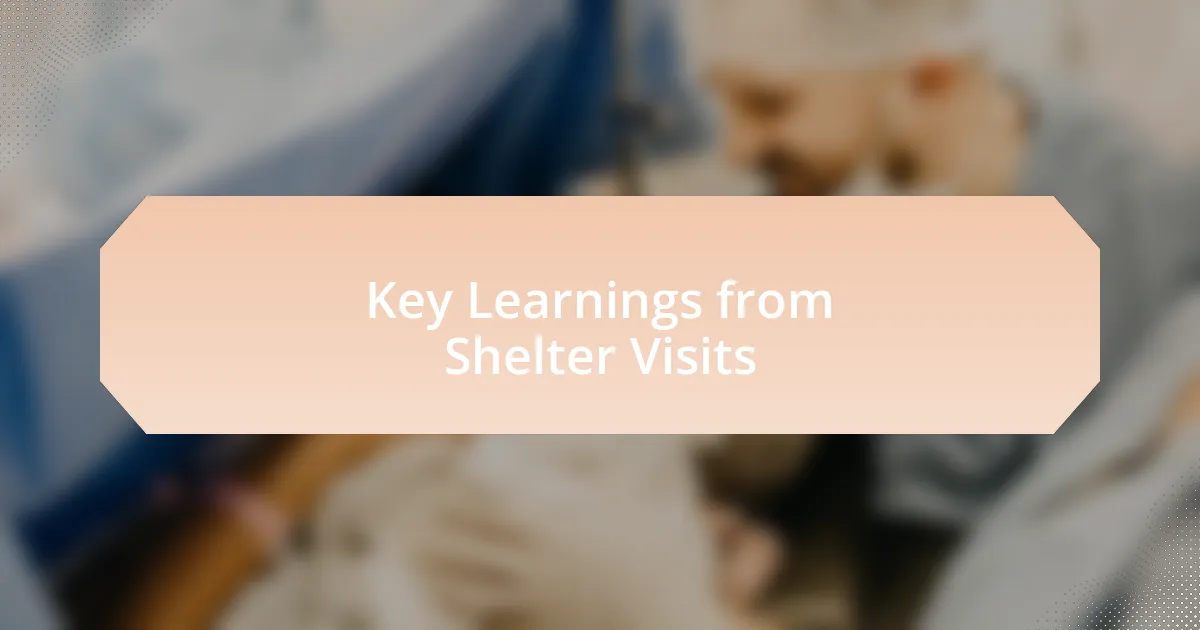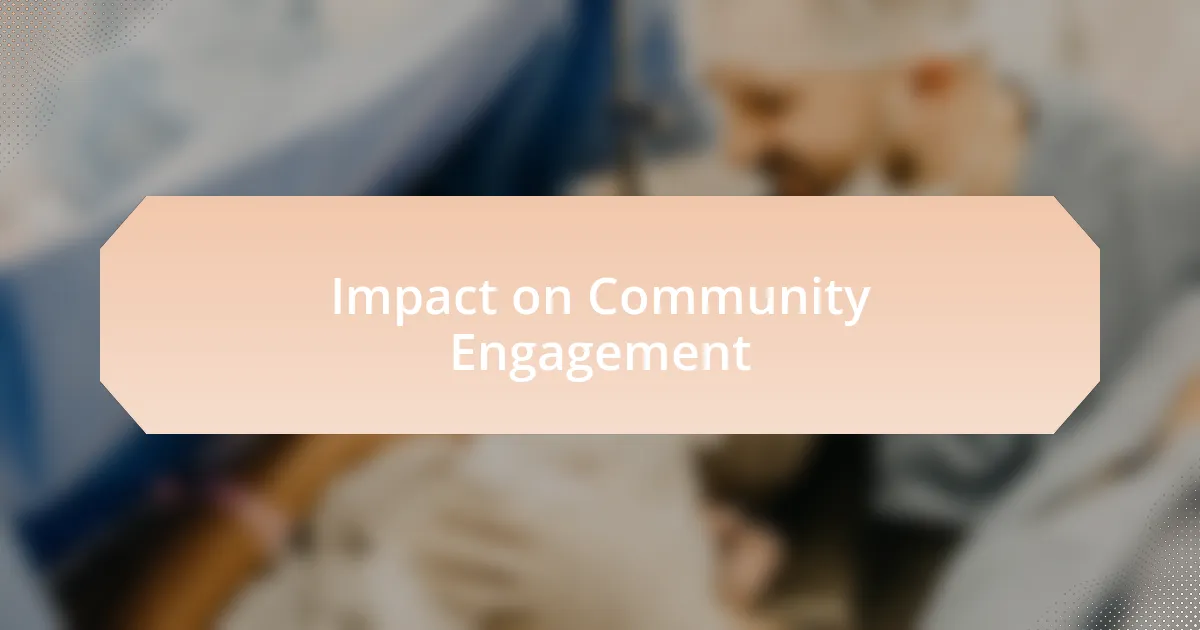Key takeaways:
- Hospital ministry emphasizes the importance of addressing emotional and spiritual needs alongside physical healing, fostering genuine connections through active listening and presence.
- Shelters act as critical support systems, promoting community, emotional warmth, and resource access, while highlighting the transformative power of shared experiences among residents and volunteers.
- Visiting shelters reinforces personal growth and empathy, demonstrating how simple acts of kindness can create bonds and foster renewed purpose in both residents and volunteers.
- Effective ministry planning involves understanding community needs, incorporating engaging activities, and setting measurable goals to ensure lasting impact and positive change.

Understanding Hospital Ministry
Hospital ministry is a unique blend of compassion, service, and support, often encompassing the emotional and spiritual needs of patients and their families. I remember walking through the halls of a local hospital during one of my ministry visits, feeling an overwhelming sense of purpose as I connected with those facing life-altering challenges. Have you ever considered how a simple smile or encouraging word can transform someone’s day in such a vulnerable setting?
The essence of hospital ministry lies in recognizing that healing is not just physical but also emotional and spiritual. I once sat with a patient who shared her fears of what lay ahead after a recent diagnosis. As we talked, it struck me how vital it is to offer not just prayers, but also genuine presence—to listen, to share, and sometimes simply to be. What insights can we gain from these experiences that go beyond traditional ministry?
Through hospital ministry, I’ve learned that each visit can be an opportunity for growth, not just for the patients, but for the ministers as well. I found myself reflecting on my own vulnerabilities during a visit to a young mother battling cancer; her bravery and faith inspired me in ways I never expected. How often do we allow ourselves to feel the weight of another’s burdens and, in doing so, discover resilience within ourselves?

The Role of Shelters
When I first visited a shelter, I was taken aback by the sheer diversity of people seeking refuge—families, individuals, and even veterans. Each story I encountered revealed the shelter’s role as a haven, providing not just a roof over their heads, but also a sense of community. Isn’t it enlightening to think about how these spaces foster connections among those who often feel isolated in their struggles?
Shelters serve as crucial lifelines, offering not only physical safety but also access to resources like counseling and job training. I recall a young man I met who attributed his recovery from homelessness to the support he received at a local shelter, where he learned to rebuild his confidence and skills. This experience led me to wonder: how often do we underestimate the power of community support in transforming lives?
The emotional warmth of shelters is palpable; they offer hope in times of despair. During a recent visit, I witnessed an impromptu gathering where residents shared stories and laughter, momentarily rising above their circumstances. It made me realize that shelters are more than just facilities; they are places where human dignity is restored, and friendships are forged in the most unlikely of places. What can we learn from these resilient individuals?

Benefits of Visiting Shelters
Visiting shelters opened my eyes to the profound impact a simple act of kindness can have on both residents and volunteers. I remember a particular day when I brought in some homemade sandwiches. The smiles I received in return were incredibly rewarding. It struck me how sharing a meal can create such an immediate bond and provide a moment of joy in difficult times. Doesn’t it remind us all of the importance of connection, even in the simplest ways?
One of the most striking benefits of visiting shelters is the exchange of perspectives. During a discussion circle at one shelter, I was surprised to learn about the diverse backgrounds and experiences of the residents. Their stories of resilience and personal growth inspired me to reflect on my own life challenges. How often do we allow ourselves to be transformed by the experiences of others? I found that these exchanges not only broaden our understanding but also enrich our empathy and compassion.
Lastly, engaging with those in shelters fosters a renewed sense of purpose. After volunteering for a few weeks, I began to notice a shift within myself; my previously mundane worries seemed minuscule compared to the struggles faced by many. Every time I left the shelter, I carried with me a sense of gratitude and a commitment to contribute positively to my community. Isn’t it interesting how stepping out of our comfort zones can lead to personal growth and fulfillment?

Key Learnings from Shelter Visits
Visiting shelters taught me the vital importance of active listening. I vividly recall a moment when a resident shared her story about overcoming addiction. As I sat there, quietly absorbing her experiences, I realized how empowering it can be to simply lend an ear. How often do we overlook the power of listening in our day-to-day lives?
Another key learning was how creativity can be a lifeline. I once participated in a painting workshop with shelter residents, and the joy on their faces as they expressed themselves was unforgettable. This experience made me appreciate how creative outlets can serve as therapeutic tools. Can you imagine the effect of channeling emotions into art, especially for those who may feel unheard?
Finally, I discovered that hope can be ignited through community support. One evening, I helped organize a small event showcasing the talents of shelter residents. Witnessing their pride and confidence as they performed made me realize that a little encouragement can go a long way. Isn’t it amazing how a supportive environment can foster resilience and rebuild self-esteem?

Personal Reflections on Experiences
Reflecting on my shelter visits, I find that genuine connection often blooms in unexpected moments. One afternoon, I helped serve meals and locked eyes with a resident who was initially withdrawn. At that moment, he shared a fleeting smile, and it struck me how small gestures can bridge vast distances. It made me wonder: when was the last time I genuinely connected with someone over something as simple as a shared meal?
Another poignant memory was a late-night conversation with a mother and her young child. She spoke about her fears of the future, her voice trembling with uncertainty. I felt the weight of her reality and realized that her story wasn’t just about shelter; it was about survival and the relentless fight for a better tomorrow. Have I ever fully acknowledged the silent battles that others may be enduring?
I often think about the moments of laughter shared during group activities. One day, during a game night, a resident cracked a joke that sent everyone into fits of laughter. That lightness lingered long after the games ended, and I wondered how healing laughter can be in the face of adversity. Isn’t it remarkable how humor can unite fragile hearts, even in the toughest circumstances?

Impact on Community Engagement
Visiting shelters revealed to me the profound ripple effect community engagement can have. I remember one Saturday afternoon, a local church volunteered to organize a clothing drive at the shelter. As residents and volunteers mingled, I was struck by the warm conversations that sparked between them, breaking down barriers. Is there a more beautiful sight than strangers turning into allies, creating a tapestry of hope together?
I also learned that sharing resources strengthens community ties in a very tangible way. When a family from the neighborhood brought in homemade meals, it wasn’t just food being shared—it was a reminder that everyone has something to offer. Watching the residents enjoy those meals brought a sense of belonging that I hadn’t anticipated. Have you ever thought about the power of simply sharing a meal with someone? It can turn a casual encounter into a meaningful exchange.
The stories exchanged during these visits left a lasting impression on me. One evening, I met an elderly gentleman who had volunteered at the shelter for years. His tales of transformation inspired others to engage more actively. His passion for helping others reminded me that community engagement is not a one-time act, but a continuous journey. What would happen if we all committed to one small act of kindness every day?

Developing a Ministry Plan
Developing a ministry plan requires a thoughtful approach, blending vision with actionable steps. During one shelter visit, I observed how a simple needs assessment, where volunteers chatted with residents about their challenges, became the foundation of a targeted outreach program. Have you ever considered how understanding specific needs can truly shape your ministry’s impact?
As I worked alongside a dedicated team to draft our ministry plan, I remember brainstorming sessions filled with passion and purpose. One team member shared their experience of how a seasonal event—like a holiday party—brought life into the shelter, creating a space where joy and community thrived. It made me realize that incorporating regular events in our plan could foster lasting connections and uplift spirits. Isn’t it inspiring to think about how intentional planning can create joy for those in need?
An essential part of our ministry plan development involved setting measurable goals to track our progress. I discovered that without clear targets, enthusiasm could easily dwindle over time. For instance, after we committed to offering monthly support workshops, we celebrated not only participation metrics but also the heartfelt testimonies from attendees about their transformation. How rewarding it is to see goals translate into real, positive change!